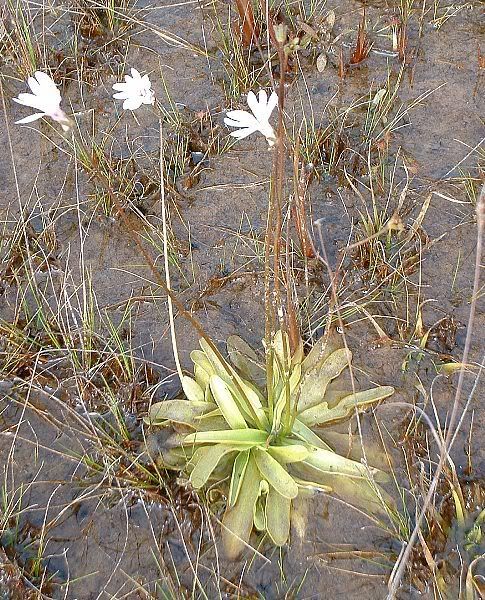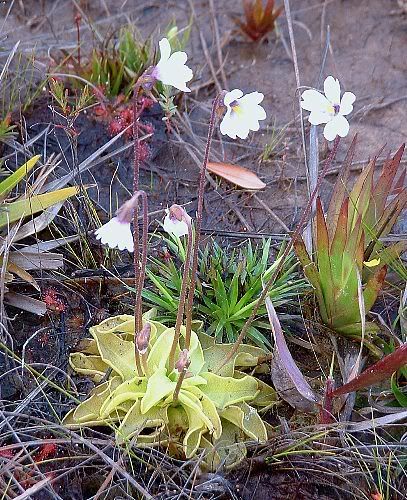|
|
Post by Brian Barnes on Sept 24, 2008 9:16:18 GMT -5
Hello All! I've just finished posting a new field report on the FCPS site that is quite interesting, regarding the hypothesis of possible hybridization between Pinguicula planifolia and Pinguicula ionantha. It can be found here; www.floridacarnivorousplantsociety.org/pplanifoliarevisited.htmHappy Growing! Brian. Below; photo taken in habitat where P. planifolia and P. ionantha zones merge in the Fl. Panhandle...  |
|
|
|
Post by daniel on Sept 25, 2008 18:00:07 GMT -5
Hi Brian, very nice pictures and the report is very interesting too.  Most i like the pictures where the P. planifolia are only partially submerged, not totally. Till now i have not known that P. ionantha can also grow submerged like P. planifolia. I also have not known that there are existing locations where both species are growing next to each other. Is this location submerged the hole year or only during a few months? You really seem to have found hybrids between both of them, congratulation. Next season you must see if these "intermediate" plants have also these "intermediate" flowers. Is one of both growing somewhere together with P. caerulea, P. primuliflora, P. lutea or P. pumila? Perhaps there are existing hybrids. Till now i have not heard about any north american Pinguicula hybrids, but who knows. Is this white flowering P. lutea you mentioned in one of your other reports perhaps a hybrid between P. lutea and P. ionantha? Are they growing there together? Till now i have not heard that somebody had been successful with cross pollination, that wonders me a little bit, perhaps it is not possible with all of them?  Thanks for sharing these pictures.  Best regards, Dani |
|
|
|
Post by Brian Barnes on Sept 26, 2008 16:58:57 GMT -5
Hi Dani, I'm glad you enjoyed the report, thank you! Yes, the photos of the plants submerged were hard to capture clearly, especially under several inches of water in full sun...But it does show just how happy these species are when underwater. Pinguicula planifolia and Pinguicula ionantha are the only two mentioned species that I've noted growing anywhere next to each other. The closest that P. lutea, P. caerulea and P. pumila get to this zone is still about 4 miles north of this site... P. primuliflora begins about 40 miles to the West! P. ionantha is extremely rare and only exists in this locale pictured and one other site in the Fl. Panhandle. It's zone never crosses with any other Pinguicula other than P. planifolia, hence it's water-loving habit!  To confuse matters more, there are P. ionantha with purple flowers and P. planifolia with white flowers! A mystery that i will continue to work on and i must say that I'm quite intrigued... Happy Growing, Brian. |
|
|
|
Post by daniel on Sept 29, 2008 17:48:18 GMT -5
Hi Brian, i wonder if these submerged plants are able to catch anything or are they doing this only in the period when they are not submerged? So, after your observation only one natural hybrid is possible, really interesting.  After they are growing next to each other the possibility is very high to find hybrids between both of them. But this point is not every time the case; for example there are existing a lot of south american Drosera that are growing next to each other and there are not existing hybrids between them (perhaps there are existing hybrids only in the hirtella- or tomentosa-complex). Are all these Pinguicula (pumila, lutea, caerulea, primuliflora, ionantha, planifolia)flowering at the same time in nature and have you ever tried to cross them? Best regards, Dani |
|
jeff
Forum Member

Posts: 79 
|
Post by jeff on Sept 30, 2008 5:07:51 GMT -5
here in europe we have a lot of species in the same station , not any naturel hybrids . I know just 2 but no real confirmation with a artificial method . we have also a chance with temperate , they make seeds but also buds ideal to survive if these hybrids exist . normaly planifolia : 2n : 32 ionantha: 2n : 22 for the colour ionantha : white to white-purplish blue planifolia: white to purplish blue- mauve BRIAN I hope you find this hybrid , good luck  have you some infos on P.caerulea var leucantha (white form) P.lutea f alba (white form) P.pumila var buswelli (yellow form) I am very interested jeff |
|
|
|
Post by Brian Barnes on Oct 2, 2008 6:13:36 GMT -5
Hi Dani and Jeff, I have seen what i believe are a few very small larvae of some sort on the leaves during submersion, but i do know that the mucilage that is existent at that time is much thinner than when not submerged. I wonder myself if digestion is even possible at this time... To my knowledge, plants must have similar chromosome numbers in order to successfully cross-pollinate, which would also explain the lack of South American Drosera hybrids as you have mentioned. However, I have also heard that these chromosome numbers can change over a period of years, which could possibly open a "window of opportunity" for two species that constantly exist with one another....interesting indeed!  I did try to cross P. planifolia with P. ionantha some years back and got a few seed that produced a few weak and sickly-looking plants. Unfortunately, they died long before they could flower. In the wild, The other species you have questioned are usually just beginning to flower, as P. planifolia and P. ionantha are finishing! This is also true for me in cultivation as well... Maybe that explains why I've never had a successful cross, along with the fact of the chromosome numbers not quite matching. What would really be interesting is if flowering times between species become closer to each other as the chromosome numbers change! I've never seen P.caerulea var leucantha (white form) in the wild and as far as i know P. pumila var buswelli (yellow form) is now extinct. I saw them in South Florida about 15 yrs. ago and even then there were only 5 or 6 plants. Sources in that area now say that they can no longer be found, which is quite disheartening, since that's the only place in the world that they could once be found. Very disappointing indeed.... Happy Growing, Brian |
|
jeff
Forum Member

Posts: 79 
|
Post by jeff on Oct 3, 2008 2:43:06 GMT -5
we have in europe a same submerged phenomen on P.lusitanica . under the water no possibility for them to catch prey . ionantha and planifolia have the same nomber of chromosome ? for me I think that these chromosome do not change . to have a sure hybrid you must have in 3 years consecutive the same morphologic caracters 3 questions for planifolia have you a naturel vegetative multiplication ( plantlets or others) ? for pumila it is a annual species ? for the others what livespan ? domage for the pumila var buswelli , no possibility to find some one in collection ? you must be attentive for the lutea f alba  jeff |
|
|
|
Post by Brian Barnes on Oct 4, 2008 7:55:21 GMT -5
Hi Jeff,
I've never had any luck with leaf cuttings of P. planifolia, however my plants are clump-forming and will fill a pot full within a few years. P. pumila does behave as an annual and usually dies after it "flowers itself to death" here in the wild and in cultivation.
To my knowledge, I know of no one nowadays who has the P. pumila var bushwelli form in their collections, which is sad. I have seen P. caerulea and P. lutea live for over a year in the wild and in cultivation, behaving like a perennial.
Happy Growing,
Brian.
|
|
|
|
Post by daniel on Oct 4, 2008 20:20:02 GMT -5
Hi Briaan and Jeff, what a pity that P. pumila var. buswelli has not be taken in culture before it dissapeared, but you hopefully will find it some day somewhere in nature. A few years ago i tried leafcuttings from P. ionantha and P. planifolia and it worked, not very good but a few plantletts have made it. Later i have lost them and my P. planifolia motherplant because of wrong conditions (perhaps too low waterlevel).  My P. ionantha motherplant is still living and it also seems to be clump-forming like your P. planifolia, now i have 3 growing points.  Best regards, Dani |
|
jeff
Forum Member

Posts: 79 
|
Post by jeff on Oct 5, 2008 5:49:51 GMT -5
BRIAN and DANIEL many thanks for all these infos.
what is it of lutea f alba, in danger or not?
for that , before it do not disappear I think that an operation of setting in culture would not be a luxury.
my question is the same one for all the US ping subtropical ( pumila,caerulea,planifolia,lutea,ionantha,primuliflora) you who know them of course ?
jeff
|
|
|
|
Post by rzerr on Jun 2, 2009 23:17:47 GMT -5
Hi Brian. I see the green planifolias all over the panhandle. Sometimes it's tough to tell them apart. There very well may be hybrids in Apalachicola NF.  green Pinguicula planifolia ? with white flowers  Pinguicula ionantha Pinguicula ionantha |
|
|
|
Post by Brian Barnes on Jun 3, 2009 6:44:37 GMT -5
Hey Randy,
I agree firmly....
Too many of these "in between" plants up that way. I believe that the two are more closely related than once thought.
Compare to the 'alba' anomaly in Pinguicula lutea forma alba. Maybe it should get a separate species name like P. ionantha does? Hehehe... ;D
Happy Growing,
Brian.
|
|
jeff
Forum Member

Posts: 79 
|
Post by jeff on Jun 5, 2009 0:04:13 GMT -5
I am not sure like you .
you want to say that planifolia and ionantha can be the same plant but with 2 different name because their color?
on planifolia -ionantha-lutea-pumila-caerulea we have a lot of test to make to confirm different form .
to have a new form ( or other)on planifolia (or other) you must make some perenial and reproductibility test , if these one are OK then they can consider OK , like planifolia f alba per example if this one live in community with planifolia (type) or planifolia var alba if they live alone
jeff
|
|